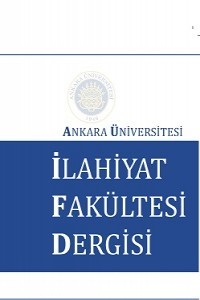Hz. Muhammed'e Dair Bir Yahudi Efsanesi: Ma ase Mahmat Adlı Risalenin Yeniden Tahkik ve Tercümesi
Yahudi geleneğinde bazı hahamların Hz. Muhammedin çevresinde faaliyet gösterdikleri, onu kendi planları doğrultusunda yönlendirdikleri ve Kuranı ona kendilerinin yazdırdığı yaygın bir anlayıştır. Bu amaçla Yahudiler tarafından menkıbevî anlatımlar ve aktarımlar içeren irili ufaklı çok sayıda eser üretilmiştir. Bu makalede, bu genel anlayışın bir uzantısı niteliği taşıyan kısa hacimli anonim bir eserin tenkitli neşri ve Türkçe tercümesi gerçekleştirilmiştir. Katalog kayıtlarına göre 18. yüzyılda İtalyada istinsah edilen bu eser, Boaz Cohen tarafından Une Légende Juive de Mahomet adıyla daha önceden neşredilmiş, bu neşir üzerinden de Nuh Arslantaş tarafından Türkçeye çevrilmişti. Ancak bu ilk neşirde bazı cümle düşüklükleri ve anlatım bozuklukları söz konusuydu. Bunun teyidi amacıyla da eserin el yazmasının bir kopyası tarafımızdan temin edilmiş ve ilk neşirle karşılaştırılmıştır. Cohenin bazı ifadeleri yanlış okuduğu ve kimi zaman da satır atladığı fark edilmiştir. Bu yüzden İbranice metnin yeniden neşredilmesinin doğru olacağına karar verilmiş, bu metin üzerinden de yeniden Türkçeye çevrilmiştir.
A Jewish Legend about the Prophet Muhammad: A New Edition and Turkish Translation of Ma ase Mahmat
There is a common understanding in Jewish tradition that certain Jewish rabbis around the Prophet Muhammad had contrived a plot to manipulate him and most importantly to dictate the Qur ān to the prophet. There have been a large number of mythic narratives produced by Jews to that effect. In this article, a short anonymous story of this same sort about the prophet Muhammad is edited along with a new Turkish translation of it. The Hebrew manuscript, which according to its catalogue records was written in the 18th century Italy, was first edited by edited by Boaz Cohen with the title Une Légende Juive de Mahomet and was translated into Turkish by Nuh Arslantaş. A check against the original text revealed that the Cohen edition has a number of misread words and skipped lines. We therefore decided that a new edition of the manuscript and a new Turkish translation thereof should be made, which we present in this article.
___
- Allaire, Gloria. Noble Saracen or Muslim Enemy? The Changing Image of the Saracen in Late Medieval Italian Literature, Michael Frassetto, David R. Blanks (ed.), Western Views of Islam in Medieval and Early Modern Europe (New York: St. Martins Press, 1999) içinde, ss.173-84.
- Arslantaş, Nuh. Yahudilere Göre Hz. Muhammed ve İslamiyet. İstanbul: İz Yayıncılık, 2011.
- Bar-Asher, Moshe. Al Kama Hiduşey ha-Laşon, Masorot 5-6 (1998), ss.45-7.
- Curiosities for the Ingenious. Londra: Thomas Boys, 1822.
- Cohen, Boaz. Une Legende Juive de Mahomet, Revue des Etudes Juives 88 (1929), ss.1-17.
- Daniel, Norman. Islam and the West: The Making of an Image. Oxford: Oneworld Publications, 1993.
- Edwards, Cyril. Wolfram von Eschenbach, Islam and, the Crusades, James R. Hodkinson, Jeffrey Morrison (ed.), Encounters with Islam in German Literature and Culture (Rochester, NY: Camden House, 2009) içinde, ss.36-54
- Eschenbach, Wolfram von. Willehalm. Berlin: Walter de Gruyter, 2003.
- Feyyumî, Natanel ben. Bustānul- Uḳūl. ed. Yosef Kafih. Kudüs: Halihot Am Yisrael, 1984.
- Geiger, Abraham. Was hat Mohammed aus dem Judentume aufgenommen? Bonn: F. Baaden, 1833.
- Gerondi, Rabbi Nissim. Hiduşey ha-Ran al Masehet Sanhedrin. Kudüs, 1972.
- ----------. Şeelot u-Teşuvot. Varşova: Bi-defus Y. Goldman, 1882.
- Guillaume, Alfred. The Influence of Judaism on Islam, Edwyn Bevan (ed.), Legacy of Israel (Oxford: The Clarendon Press, 1928) içinde, ss.129-172.
- Hıdır, Özcan. İslamın Yahudi Kökeni Teorisi ile İlgili İddialar ve Çalışmalar, İLAM Araştırma Dergisi 3:1 (1998), ss.155-169.
- Katsh, Abraham I. Judaism and the Koran: Biblical and Talmudic Backgrounds of the Koran and Its Commentaries. New York: A. S. Barnes, 1962.
- Leveen, J. Mohammed and His Jewish Companion, Jewish Quarterly Review 16:4 (1926), ss.399-406.
- Lewis, Bernard. An Apocalyptic Vision of Islamic History, Bulletin of the School of Oriental and African Studies 13:2 (1950), ss.308-338.
- Malakhov, A. The Mystery of the Earths Mantle. Hawaii: University Press of the Pacific, 2001.
- Mavor, William. Historical Account of the Most Celebrated Voyages, Travels, and Discoveries from the Time of Columbus to the Present Period. London, 1797.
- Moncreiff, Charles Kenneth (terc.), The Song of Roland, http://www.gutenberg.org/cache/epub/391/pg391.html (22.09.2012).
- Munro, Dana Carleton. The Western Attitudes Toward Islam during the Period of the Crusades, Speculum 6 (1931), ss.329-43.
- OHagan, John (terc.). The Song of Roland, http://www.fordham.edu/halsall/basis/roland-ohag.asp (22.09.2012).
- Rosenthal, Erwin I. J. Judaism and Islam. Londra & New York: T. Yoseloff, 1961.
- Semav el el-Maġribī. Ifḥām al-Yahūd = Silencing the Jews. Ed. Moshe Perlmann. Proceedings of the American Academy for Jewish Research, c.32. New York: American Academy for Jewish Research, 1964.
- Schwabe, M. Aseret Haverav ha-Yahudîm şel Muhammed. Tarbits 2 (1930), ss.74-89.
- Steinschneider, Moritz. Polemische und Apologetische Literatur in Arabischer Sprache Zwischen Muslimen, Christen und Juden. Leipzig: F. A. Brockhaus, 1877.
- Şerira Gaon. İggeret Rav Şerira Gaon. Ed. Benjamin Manasseh Lewin. Hayfa, 1921.
- Tefilat Rabbi Şimon bar Yohay, Adolph Jellinek (ed.), Bet ha-Midraş = Bet ha-Midrasch (Leipzig: Druck und Verlag von C.W. Vollrath, 1857) içinde, c.4, s.117-126.
- Torrey, Charles Cutler. Jewish Foundation of Islam. New York: Jewish Institute of Religion Press, 1933.
- The British Controversialist and Literary Magazine. Londra, 1860.
- ISSN: 1301-0522
- Yayın Aralığı: Yılda 2 Sayı
- Başlangıç: 1952
- Yayıncı: ANKARA ÜNİVERSİTESİ > İLAHİYAT FAKÜLTESİ
Sayıdaki Diğer Makaleler
Hz. Muhammed'e Dair Bir Yahudi Efsanesi: Ma ase Mahmat Adlı Risalenin Yeniden Tahkik ve Tercümesi
Şeyḫ Adī’siz Yezidîlik: Yezidîlerin Adī b. Musāfir algısında yaşanan farklılaşmalar
Güneydoğu medreselerinde eğitim-öğretim faaliyetleri: Mardin örneği
Corpus Coranicum projesi: Kur’an’ı Geç Antik döneme ait bir metin olarak okumak
Esra GÖZELER, Michael MARX, David KILTZ, Yousef KOURIYH, Hannelies KOLOSKA, Nora K. SCHMID
Kemālpāşāzāde’nin Eşarīlik-Māturīdīlik ihtilafı konusundaki risalesi üzerine
